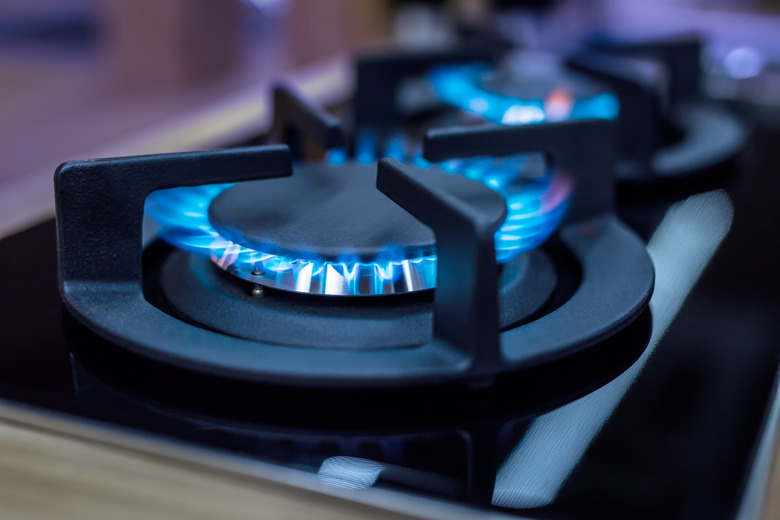How To Calculate Heat Absorption
In everyday language, people use the terms heat and temperature interchangeably. In the field of thermodynamics and physics more broadly, though, the two terms have very different meanings. If you're trying to calculate how much heat is absorbed by something when you raise its temperature, you need to understand the difference between the two and how to calculate one from the other. You can do this easily: just multiply the heat capacity of the substance you're heating by the mass of the substance and the change in temperature to find the heat absorbed.
TL;DR (Too Long; Didn't Read)
Calculate heat absorption using the formula:
_Q_ = _mc_∆_T_
_Q_ means the heat absorbed, _m_ is the mass of the substance absorbing heat, _c_ is the specific heat capacity and ∆_T_ is the change in temperature.
The First Law of Thermodynamics and Heat
The First Law of Thermodynamics and Heat
The first law of thermodynamics states that the change in internal energy of a substance is the sum of the heat transferred to it and the work done on it (or the heat transferred to it minus the work done by it). "Work" is just a word physicists use for physical energy transfer. For example, stirring a cup of coffee does work in the liquid inside it, and you do work on an object when you pick it up or throw it.
Heat is another form of energy transfer, but it's one that takes place when two objects are at different temperatures to each other. If you put cold water in a pan, and turn on the stove, the flames heat the pan and the hot pan heats the water. This raises the temperature of the water and gives it energy. The second law of thermodynamics dictates that heat only flows from hotter objects to colder ones, not the other way around.
Specific Heat Capacity Explained
Specific Heat Capacity Explained
The key to solving the problem of calculating heat absorption is the concept of specific heat capacity. Different substances need different amounts of energy to be transferred to them to raise the temperature, and the specific heat capacity of the substance tells you how much that is. This is a quantity given the symbol c and measured in joules / kg degree Celsius. In short, the heat capacity tells you how much heat energy (in joules) is needed to raise the temperature of 1 kg of a material by 1 degree C. The specific heat capacity of water is 4,181 J / kg degree C, and the specific heat capacity of lead is 128 J/ kg degree C. This tells you at a glance that it takes less energy to increase the temperature of lead than it does water.
Calculating Heat Absorption
Calculating Heat Absorption
You can use the information in the last two sections along with one simple formula to calculate the heat absorption in a specific situation. All you need to know is the substance being heated, the change in temperature and the mass of the substance. The equation is:
_Q_ = mc∆_T_
Here, Q means heat (what you want to know), m means mass, c means the specific heat capacity and ∆_T_ is the change in temperature. You can find the change in temperature by subtracting the starting temperature from the final temperature.
As an example, imagine increasing the temperature of 2 kg of water from 10 degrees C to 50 degrees C. The change in temperature is ∆_T_ = (50 – 10) degrees C = 40 degrees C. From the last section, the specific heat capacity of water is 4,181 J / kg degree C, so the equation gives:
_Q_ = 2 kg × 4181 J / kg degree C × 40 degrees C
= 334,480 J = 334.5 kJ
So it takes about 334.5 thousand joules (kJ) of heat to raise the temperature of 2 kg of water by 40 degrees C.
Tips on Alternate Units
Tips on Alternate Units
Sometimes specific heat capacities are given in different units. For example, it may be quoted in joules / gram degrees C, calories / gram degrees C or joules / mol degrees C. A calorie is an alternate unit of energy (1 calorie = 4.184 joules), grams are 1/1000 of a kilogram, and a mole (shortened to mol) is a unit used in chemistry. As long as you use consistent units, the formula above will hold.
For example, if the specific heat is given in joules / gram degree C, quote the mass of the substance in grams too, or alternatively, convert the specific heat capacity into kilograms by multiplying it by 1,000. If the heat capacity is given in joules / mol degree C, it's easiest to quote the mass of the substance in moles too. If the heat capacity is given in calories / kg degree C, your result will be in calories of heat instead of joules, which you can convert afterwards if you need the answer in joules.
If you encounter Kelvin as a unit for temperature (symbol K), for changes in temperature this is exactly the same as Celsius, so you don't really need to do anything.
Cite This Article
MLA
Johnson, Lee. "How To Calculate Heat Absorption" sciencing.com, https://www.sciencing.com/calculate-heat-absorption-6641786/. 23 April 2018.
APA
Johnson, Lee. (2018, April 23). How To Calculate Heat Absorption. sciencing.com. Retrieved from https://www.sciencing.com/calculate-heat-absorption-6641786/
Chicago
Johnson, Lee. How To Calculate Heat Absorption last modified August 30, 2022. https://www.sciencing.com/calculate-heat-absorption-6641786/
